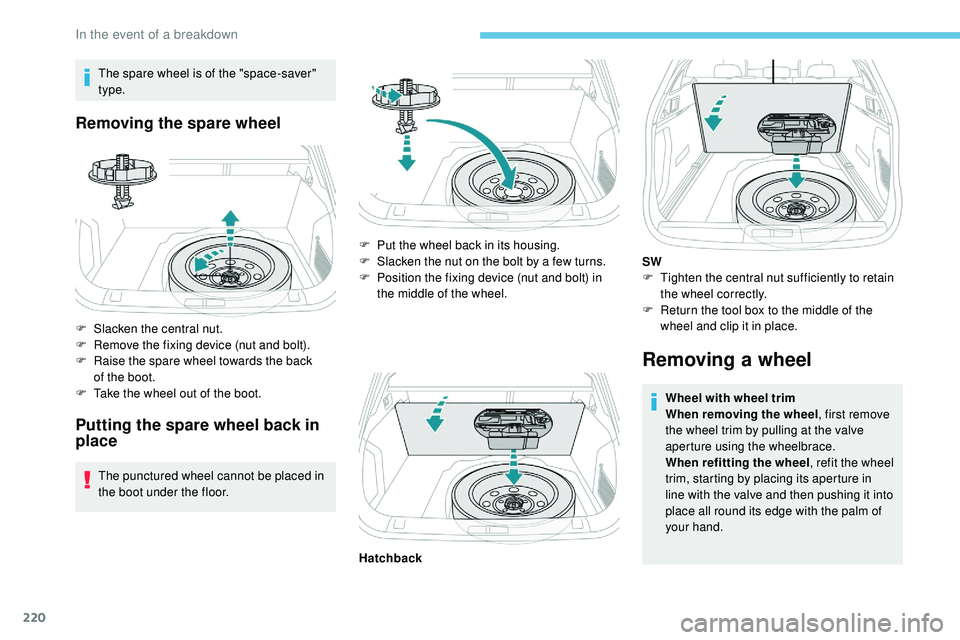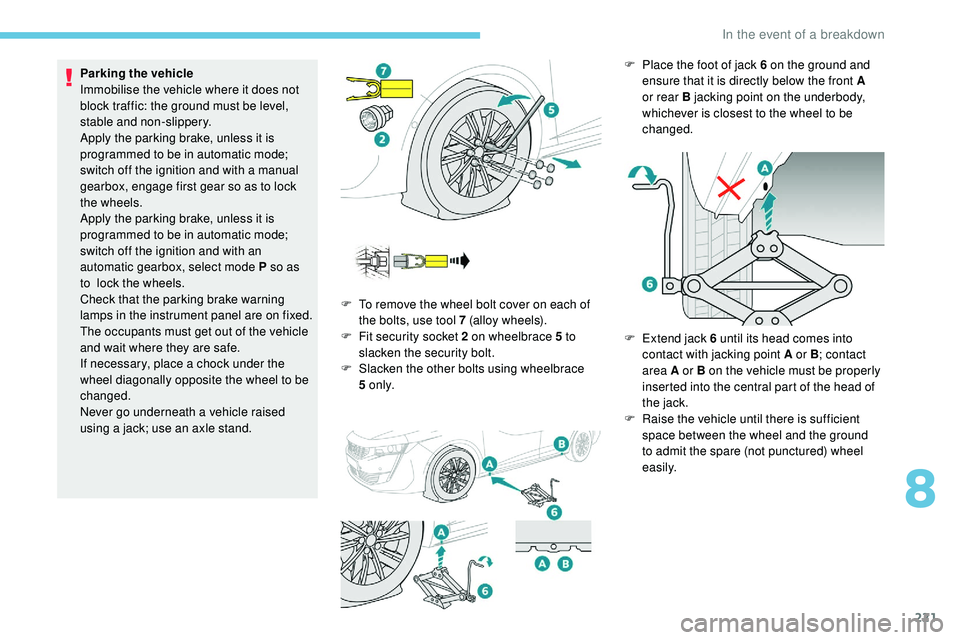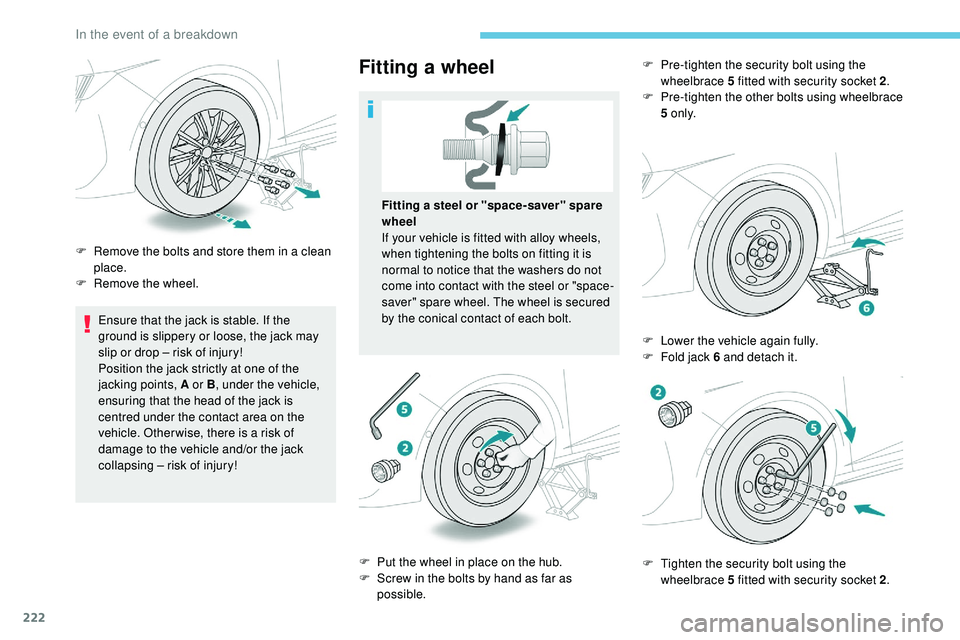2019 Peugeot 508 spare wheel
[x] Cancel search: spare wheelPage 217 of 320

215
The jack must only be used to change a
wheel with a damaged or punctured tyre.
Do not use any jack other than the one
supplied with this vehicle.
If the vehicle does not have its original jack,
contact a PEUGEOT dealer or a qualified
workshop to obtain the correct jack for it.
The jack meets European standards,
as defined in the Machinery Directive
2006/42/CE.
The jack does not require any
maintenance.
List of tools
1.Chock to immobilise the vehicle (depending
on equipment).
2. Socket for the security bolts (located in the
glove box) (depending on equipment).
For adapting the wheelbrace to the special
"security" bolts.
3. Removable towing eye.
For more information on Towing the vehicle
and using the removable towing eye, refer to
the corresponding section.
With temporary puncture
repair kit
For more information on the Temporary
puncture repair kit , refer to the corresponding
section.
With spare wheel
For more information on the Spare wheel ,
refer to the corresponding section.
4.
Temporary puncture repair kit.
Contains a 12
V compressor and a
cartridge of sealant to temporarily repair
the wheel and adjust the tyre pressure,
as
well as a speed limit sticker.
5.
Wheelbrace.
For removing the wheel trim and removing
the wheel bolts.
6. Jack with integrated handle.
Used to raise the vehicle.
7. Wheel bolt cover remover (depending on
equipment).
For removing the wheel bolt head finishers
on alloy wheels.
8
In the event of a breakdown
Page 221 of 320

219
If a pressure of 2 bars is not reached after
7 minutes, this indicates that the tyre is not
repairable; contact a PEUGEOT dealer or
a qualified workshop for assistance.
F
O
nce the correct pressure is reached, put
the switch in the " O" position.
F
R
emove the kit then stow it. Do not drive more than 125 miles (200
km)
with a repaired tyre; see a PEUGEOT
dealer or a qualified workshop to change
the tyre.
Should the pressure of one or more tyres
be adjusted, it is necessary to reinitialise
the under-inflation detection system.
For more information on Tyre under-
inflation detection , refer to the
corresponding section.
Spare wheel
Scan the QR code on page 3 to view
explanatory videos.
Procedure for changing a damaged wheel with
the spare wheel using the tools provided with
the vehicle.
Access to the spare wheel
The spare wheel is installed in the boot under
t h e f l o o r.
For access to the spare wheel, first refer to
section on the Toolkit .
F
S
tart the compressor by placing the switch
in the " I" position and adjust the pressure
to the value shown on the vehicle's tyre
pressure label. To deflate: press the black
button located on the compressor pipe, near
the valve connection. Hatchback
SW
8
In the event of a breakdown
Page 222 of 320

220
The spare wheel is of the "space-saver"
type.
Removing the spare wheel
F Slacken the central nut.
F R emove the fixing device (nut and bolt).
F
R
aise the spare wheel towards the back
of
the boot.
F
T
ake the wheel out of the boot.
Putting the spare wheel back in
place
The punctured wheel cannot be placed in
the boot under the floor.
Removing a wheel
Wheel with wheel trim
When removing the wheel , first remove
the wheel trim by pulling at the valve
aperture using the wheelbrace.
When refitting the wheel , refit the wheel
trim, starting by placing its aperture in
line with the valve and then pushing it into
place all round its edge with the palm of
your hand.
F
P
ut the wheel back in its housing.
F
S
lacken the nut on the bolt by a few turns.
F
P
osition the fixing device (nut and bolt) in
the middle of the wheel. SW
F
T
ighten the central nut sufficiently to retain
the wheel correctly.
F
R
eturn the tool box to the middle of the
wheel and clip it in place.
Hatchback
In the event of a breakdown
Page 223 of 320

221
Parking the vehicle
Immobilise the vehicle where it does not
block traffic: the ground must be level,
stable and non-slippery.
Apply the parking brake, unless it is
programmed to be in automatic mode;
switch off the ignition and with a manual
gearbox, engage first gear so as to lock
the wheels.
Apply the parking brake, unless it is
programmed to be in automatic mode;
switch off the ignition and with an
automatic gearbox, select mode P so as
to lock the wheels.
Check that the parking brake warning
lamps in the instrument panel are on fixed.
The occupants must get out of the vehicle
and wait where they are safe.
If necessary, place a chock under the
wheel diagonally opposite the wheel to be
changed.
Never go underneath a vehicle raised
using a jack; use an axle stand. F
T
o remove the wheel bolt cover on each of
the bolts, use tool 7 (alloy wheels).
F
F
it security socket 2 on wheelbrace 5 to
slacken the security bolt.
F
S
lacken the other bolts using wheelbrace
5
o n l y.F
P lace the foot of jack 6 on the ground and
ensure that it is directly below the front A
or rear B jacking point on the underbody,
whichever is closest to the wheel to be
changed.
F
E
xtend jack 6 until its head comes into
contact with jacking point A or B ; contact
area A or B on the vehicle must be properly
inserted into the central part of the head of
the jack.
F
Ra
ise the vehicle until there is sufficient
space between the wheel and the ground
to admit the spare (not punctured) wheel
easily.
8
In the event of a breakdown
Page 224 of 320

222
Ensure that the jack is stable. If the
ground is slippery or loose, the jack may
slip or drop – risk of injury!
Position the jack strictly at one of the
jacking points, A or B, under the vehicle,
ensuring that the head of the jack is
centred under the contact area on the
vehicle. Other wise, there is a risk of
damage to the vehicle and/or the jack
collapsing – risk of injury!
Fitting a wheel
F Remove the bolts and store them in a clean place.
F
R
emove the wheel. Fitting a steel or "space-saver" spare
wheel
If your vehicle is fitted with alloy wheels,
when tightening the bolts on fitting it is
normal to notice that the washers do not
come into contact with the steel or "space-
saver" spare wheel. The wheel is secured
by the conical contact of each bolt.
F
P
ut the wheel in place on the hub.
F
S
crew in the bolts by hand as far as
possible. F
P
re-tighten the security bolt using the
wheelbrace 5 fitted with security socket 2 .
F
P
re-tighten the other bolts using wheelbrace
5 o n l y.
F
L
ower the vehicle again fully.
F
F
old jack 6 and detach it.
F
T
ighten the security bolt using the
wheelbrace 5 fitted with security socket 2 .
In the event of a breakdown
Page 225 of 320

223
After changing a wheel
With a "space-saver" type spare wheel
Driving with more than one "space-saver"
type spare wheel is prohibited.Visit a PEUGEOT dealer or a qualified
workshop as soon as possible to have the
tightness of the bolts and the pressure of
the spare wheel checked.
Have the punctured tyre examined. After
inspection, the technician will advise you
on whether the tyre can be repaired or if it
must be replaced.
Changing a bulb
The headlamps have polycarbonate
lenses with a protective coating:
F
d
o not clean them using a dr y or
abrasive cloth, nor with a detergent
or solvent product,
F
u
se a sponge and soapy water or a pH
neutral product,
F
w
hen using a high pressure washer
on persistent marks, do not keep the
lance directed towards the lamps or
their edges for too long, so as not to
damage their protective coating and
seals. Changing a bulb must only be done with
the ignition off and after the lamp has
been switched off for several minutes –
Risk of serious burns!
F
D
o not touch the bulb directly with your
fingers, use a lint-free cloth.
It is essential only to use anti-ultraviolet
(UV) type bulbs, so as not to damage the
headlamp.
Always replace a failed bulb with a new
bulb with the same type and specification.
In some weather conditions (e.g. low
temperature or humidity), the presence
of misting on the internal sur face of the
glass of the headlamps and rear lamps
is
normal; it disappears after the lamps
have been on for a few minutes.
Light-emitting diodes (LED)
For the replacement of this type of bulb,
you must contact a PEUGEOT dealer or
a
qualified workshop.
F
T
ighten the other bolts using wheelbrace
5
o n l y.
F
R
efit the bolt covers to each of the bolts
(depending on equipment).
F
S
tore the tools.
The following is recommended:
-
d
eactivate certain driving aid functions
(Active Safety Brake, Adaptive cruise
control, etc.), as indicated on the label
attached to the wheel,
-
d
o not exceed the maximum
authorised speed of 50 mph (80
km/h).
8
In the event of a breakdown
Page 313 of 320

249
W
Warning and indicator lamps ..........................10
W arning lamp, airbag ...................................... 20
W
arning lamp, braking system
.................12 , 17
Warning lamp, Diesel engine pre-heater
.......14
Warning lamp, low fuel level
...........................14
Warning lamp, parking brake
..........................12
Warning lamps
.......................................... 10, 26
Warning lamp, Service ....................................13
Warning lamp, STOP
...................................... 11
W
arnings and indicators
.................................11
Washing (advice) ........................................... 210
Weights
...............
.................................. 2 3 8 - 2 41
Welcome lighting ............................................. 37
Wheel, spare
...............................
..................209
Window controls
....................................... 52-53
Windscreen, heated
........................................ 71
Wipers
............................................................. 22
.
Alphabetical index